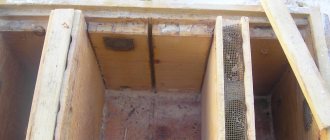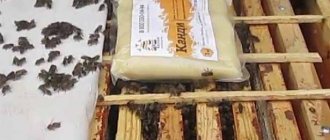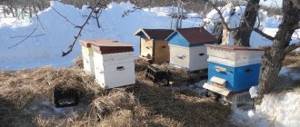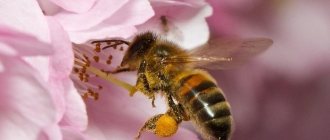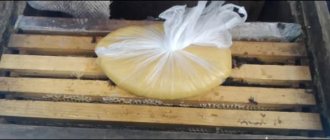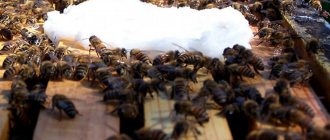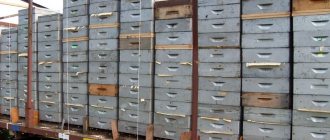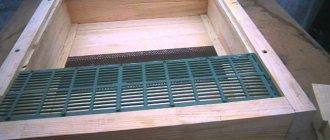Almost every person who shows an interest in beekeeping wonders how many bees are in one hive. Of course, counting insects one at a time is not an option. Firstly, this will take more than one day, since there can be tens of thousands of bees, and secondly, this is basically impossible, since insects are small in size and are in constant motion. To perform a count, you first need to study information regarding the hierarchy of insect data, and then apply one of the calculation methods.
What factors influence the number of bees in a hive
The number of all organisms is influenced by various factors and reasons. The number of people in a hive is affected by the following circumstances:
- Presence of weak uteruses. Such individuals produce weak offspring, which subsequently affects the performance of the entire family. In turn, this will cause a lag in the development of the hive;
- Problems with keeping strong families on the same level. With a constant change in their numbers, insects lose the ability to independently produce strong offspring;
- A small amount of nectar, water and bee bread. Lack of bribe negatively affects the uterus. Its brood turns out to be weak, as a result of which the total population of the hive decreases;
- Air temperature during the brood period. For good offspring, warm weather is necessary: only in this case is it possible to have a good influx of queens, as well as workers;
- The brood should be open, which will allow the worker bees to feed the queens well. All this contributes to the emergence of strong individuals in the family;
- Large number of queens. The vigor of the brood depends on the quality of the resulting queens.
How long do bees live?
The lifespan of a worker bee depends on several factors:
- climate;
- the power of the swarm;
- performance.
Working honey plants live shorter than others - up to 40 days in the summer. Individuals hatched in the fall - up to 180. The more they work, the shorter their lifespan. In nests where there is no brood, insects live up to a year. With proper care, the uterus can live up to 6 years. Alone, a bee will not survive even one day.
Common bee diseases and their control
How many bees are in one family
A family of bees can be considered a kind of state, since they have a certain hierarchy, headed by the queen. The main task of queens is to produce offspring.
Drones make up a small part of the bee colony. They come from eggs that have not been fertilized. Their main task is to mate with the queen of the family.
According to observations, one bee colony can contain about 100 males. All others become exiles. Some of them will die, some will mate with the queen of another family. Upon completion of their mission, the drones die.
The main part of the insects that populate the hive consists of working individuals that perform different functions. Responsibilities depend on age:
- The cocoon stage lasts about 3 weeks. When small bees appear on the count, from the first day they take over the experience of older individuals;
- During the first 2 weeks, bees not only eat, but also begin to clean their personal cell;
- At day 18 of life, bees begin to produce wax, which they need to build honeycombs;
- Then the young individuals move to the entrance, where they continue to observe the life of their family;
- A month after birth, workers begin to collect nectar. From this moment on, they can be considered adults.
Interesting!
It is impossible to calculate the exact number of the young population. However, within a day, one queen can lay about 2 thousand. eggs In a year, the queen is capable of laying about 150 thousand eggs. At the height of honey harvest, one bee colony can number about 80 thousand bees.
The number of bees in the nest during honey collection
Honey harvest is the period of flowering of the maximum number of honey plants, allowing insects to collect significant reserves of honey. For honey collection to be productive, the family must have not only flying bees that collect nectar and deliver it to the nest, but also young animals (hive individuals).
The latter perform the following functions:
- accept, process, place honey in honeycombs;
- seal the honeycombs with wax caps.
During honey collection, a strong family has from 50 thousand insects living in one hive, a weak one - less than 35 thousand.
Interesting! One strong family can collect two to three times more honey than several weak families with the same number. This fact is explained by the fact that in a strong nest, bees are less distracted by heating and feeding the brood and, accordingly, can freely collect nectar. This reduces the ripening time of honey and increases the life expectancy of flying individuals.
The life expectancy of bees during honey collection is:
- 60 days in a strong family;
- 35 days in an average family;
- 30 days in a weak family.
The optimal number of insects in a house during honey collection is considered to be 60-70 thousand individuals.
How the number of bees in a hive changes depending on the season
The largest population growth occurs in the spring. The reason for this is the appearance of flowering on plants, which are subsequently pollinated by bees. In mid-spring, the population in the hive can reach 80 thousand individuals.
The renewal of the insect family occurs in May. At this time, the old generation of individuals that survived the winter leaves the colony. Even before the start of summer, the number of young bees in the colony will reach 95 percent. If we translate these data into numerical form, this will amount to about 85 thousand insects.
Important! The number of individuals in each colony is different and depends on the strength of the entire family.
It is during this period that it is necessary to separate families, because if this is not done, you can lose 50 percent of the population of the colony. Immediately after separation, the bee colony begins to prepare supplies for the winter.
As autumn approaches, the queen bee slows down the rate of egg laying, and eventually stops altogether. The total number of insects is also reduced due to the fact that workers drive males out of the colony.
In winter, the colony is not involved in anything. During cold weather, many bees living in the hive die. With the onset of spring, the queen begins to lay eggs again, which is why the bee family is replenished. This insect life cycle repeats from year to year.
How are families formed?
The reproduction of bees and the formation of their families is a special process. In beekeeping, two main methods of reproduction are used - natural and artificial. The natural method involves swarming, the artificial method involves layering and division of the family.
During natural reproduction - swarming - honey bees are born from fertilized eggs. When there are too many of them in the hive, they are left without space and work, resulting in a swarming problem. An increase in the number of bees leads to the fact that they become redundant in their native hive, and then a small family of bees, led by a new queen, leaves in search of a new place of residence. At the same time, the family with the old queen remains in the hive, thus creating two viable and full-fledged families of bees. The beekeeper’s task during this period is to transfer them to a separate hive or put additional frames in the old hive.
The fact that swarming is being prepared in the hive is evidenced by the fact that the bees lay special bowls for hatching new queens - there can be 8 or 10 of them. At this time, the creation of honeycombs and nectar collection stops, the number of brood and drones increases, and egg laying stops. The queen begins to lose weight and begins to prepare to fly out and take the swarm with her.
Sometimes bees are ready to leave the hive for other reasons: due to lack of free space, poor ventilation in the hive, overheating.
The reason for swarming can also be the age of the queen, for example, if she is too old and is not able to secrete a sufficient amount of pheromones.
The swarm flies out of the nest 7-9 days after laying eggs in the queen cells. Up to half of the bees can leave the hive with a swarm, and most of them are young individuals.
Swarming bees are looking for a new place for themselves; if you do not transfer them to another hive, they can settle on trees or in the grass next to their native hive, and then fly away in an unknown direction, and it will be extremely difficult to return them.
The swarming process does not stop there; soon the second and third swarms may fly out of the hive. In the queen cells there are several more queen larvae, which, after hatching, will lead to new swarms. But their number will become less and less; at the end of swarming, the bees will destroy the queen bees that did not have time to emerge from the queen cells.
Artificial propagation allows the beekeeper to control the process of creating new colonies. It occurs with the help of layering, division or plaque on the uterus.
Before making layering, the beekeeper prepares the queens; for this, a productive colony with bee alleys and brood frames is selected. 2 or 4 frames of printed brood along with insects are transferred to another hive. Bees from two other frames are placed in the same hive and a supply of food is provided for them.
Flight bees from the layer can fly back to the parent hive, at which time a barren queen is introduced into the new colony, or a queen cell is installed.
Layering can also be done with a fertile queen; a larger number of bees and brood are placed in such a layer.
Formation of layering on video.
If you create layering from different hives, it is better to take brood and bees from strong and productive colonies. Such layerings do not weaken the parent colonies, creating new “cells” of the bee society without impoverishing the old ones.
The division of families is carried out as follows: take one family for 12 streets and 8 frames with brood. A new hive is placed nearby - the same color and shape. Up to 50% of bees, food and brood frames are transferred to it. The queen remains in the parent hive, and another fertile queen is placed in the new one. Frames with foundation are placed in both hives.
You can find out how the division of a bee colony occurs by watching the video.
Plaque on the uterus - this method is suitable only in families prone to swarming. With this method, 4 frames with brood of different ages and adult bees are transferred from the parent hive to the new one. Foundation and honeycomb are placed on the side of the brood, after which the old queen is transplanted into a new hive. A new one is placed in place of the old hive, so the bees will fly to the new place, while the old hive will be nearby.
Thus, in the old hive there will be no flying bees left, but there will be a new fertile queen, which in a short time will give birth to a large number of new worker bees.
All these methods are based on the fact that all non-flying bees sit where they are placed, and the flying ones will return to the hive to which they are accustomed, or to a new house in the place of the old one.
Several ways to count the number of bees in a hive
All beekeepers approach their work very responsibly. Many of them even keep a special diary in which they indicate the approximate population of each colony.
Of course, it is impossible to determine the exact number of individuals of an insect family. Despite this, it is still possible to calculate the approximate number of inhabitants of the hive.
In a bee family, each individual has its own direct responsibilities and must fulfill them, therefore all bees are in their place, namely:
- Nursing bees: are engaged in saturating the brood;
- Builders; carry out the construction of new cells;
- Queen: together with her retinue is located on the sowing combs.
Method 1
A standard frame can accommodate about 3.3 thousand cells. A worker bee reaches a size of 1.5 centimeters. One side of the honeycomb frame can accommodate about 1.1 - 1.15 thousand bees. If you count the number of insects on both sides, you get about 2.2 – 2.3 thousand individuals. The resulting number must be multiplied by the number of frames in the hive. Thus, it is possible to calculate the number of the entire bee family.
Method 2
The second option for determining the size of the hive population is to calculate the weight of the insect. When making this calculation, you need to take into account the type of bees being bred, since the weight of different species can vary greatly.
First of all, you need to find out the weight of the hive and frames without bees. Then, having covered the entrance, it is necessary to determine how much the hive weighs with the bees. The first number is subtracted from the second number and the result is divided by the weight of the bee. The resulting number will be the approximate number of individuals of this family.
Stages of bee brood formation
The queen lays up to two thousand eggs per day, but she is leisurely. During the development of the brood, the “queen” evaluates her activity: she walks through the honeycomb and identifies cells without larvae or eggs. If there is a free cell, she carefully walks around it, and then lowers her abdomen into it for 10-15 seconds. She leaves an egg with a soft shell at the bottom of the “house”. Each of them remains in the cell for several hours.
Treatment of bee acarapidosis with folk remedies
Formation of bee brood
The honeycomb has a glass wall, through which you can see that the shell becomes transparent and a larva is formed under it. When the egg hits the bottom, the insects lay out some larval food near it. They should not miss this time, so they constantly look at the cell. Without such food, the egg will quickly die.
After some time, the following happens.
- During hatching, the larva breaks through the egg shell and becomes shaped like the letter “c”. Insects feed it, and it takes the shape of a ring.
- The larva fills the bottom of the cell, becomes straightened and begins to move along it. Gradually, her temporary “house” becomes not enough for her.
- The larva stops taking food and moving.
- The young individual gnaws through the surface of the cell and climbs out of it.
- During this period, the old skin is shed.
After the cell is sealed, the rudiments of the organs of the mouth, legs, compound eyes and wings are formed. Development occurs before the formation of the white bee. Large eyes acquire a pinkish tint (then turn brown and black), the body begins to darken and takes on a natural color. Such changes can be observed after cutting off the caps of printed brood. Such significant growth is explained by the adequate nutrition of the larvae.
Each of them is visited by adult insects 1300 times a day. After the second day, the nature of the food becomes different: it includes honey and undigested pollen. During the last 24 hours, the nurse bee remains close to one larva for a considerable time. The young individual grows quickly and changes its skin approximately once a day.
Bee larvae
Two-queen keeping of bees in a two-hull hive
Hive for two bee colonies
increases efficiency
- Honey yield increases 1.5-2 times;
- The amount of brood and, consequently, the number of worker bees increases;
- When wintering in tandem, there is a significant saving of food and energy for the bees;
- In cool spring conditions, less effort is required to maintain the required temperature in the hive.
However, there are also disadvantages of this method: difficulty in controlling swarming, the possibility of queen conflict, poor ventilation. Therefore, some beekeepers use this method only during the main honey collection period. To do this, a double dividing grid is placed between the housings - a wooden frame with wire grids attached on both sides. The lattice nest is selected in size so that the worker bee can pass through, but the queen and drones cannot.
Shortly before the main honey collection, printed brood and queen cells are transferred from the lower body to the upper frame. After the queens have mated, another 2-3 frames with the available printed brood are placed in the upper body, and frames are lowered down from the upper one, where the brood is open. In this way the upper family is strengthened. Later, when the main honey flow ends, the beekeeper decides, depending on the results of the colonies’ work, to leave both queens or remove one.
Keeping bees in two buildings, despite some labor intensity, allows you to get many benefits with the right attitude: increase the amount of honey, develop bee colonies, and get strong layers in large families.
